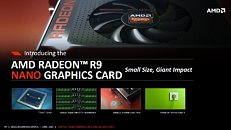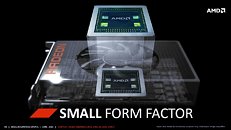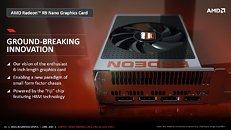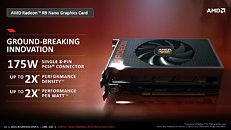Wednesday, June 17th 2015

AMD Radeon R9 Nano to Feature a Single PCIe Power Connector
AMD's Radeon R9 Nano is shaping up to be a more important card for AMD, than even its flaghsip, the R9 Fury X. Some of the first pictures of the Fury X led us to believe that it could stay compact only because it's liquid cooled. AMD disproved that notion, unveiling the Radeon R9 Nano, an extremely compact air-cooled graphics cards, with some stunning chops.
The Radeon R9 Nano is a feat similar to the NUC by Intel - to engineer a product that's surprisingly powerful for its size. The card is 6-inches long, 2-slot thick, and doesn't lug along any external radiator. AMD CEO Lisa Su, speaking at the company's E3 conference, stated that the R9 Nano will be faster than the Radeon R9 290X. That shouldn't surprise us, since it's a bigger chip; but it's the electrical specs, that make this product exciting - a single 8-pin PCIe power input, with a typical board power rated at 175W (Radeon R9 290X was rated at 275W). The card itself is as compact as some of the "ITX-friendly" custom design boards launched in recent times. It uses a vapor-chamber based air-cooling solution, with a single fan. The Radeon R9 Nano will launch later this Summer. It could compete with the GeForce GTX 970 in both performance and price.
Source:
VideoCardz
The Radeon R9 Nano is a feat similar to the NUC by Intel - to engineer a product that's surprisingly powerful for its size. The card is 6-inches long, 2-slot thick, and doesn't lug along any external radiator. AMD CEO Lisa Su, speaking at the company's E3 conference, stated that the R9 Nano will be faster than the Radeon R9 290X. That shouldn't surprise us, since it's a bigger chip; but it's the electrical specs, that make this product exciting - a single 8-pin PCIe power input, with a typical board power rated at 175W (Radeon R9 290X was rated at 275W). The card itself is as compact as some of the "ITX-friendly" custom design boards launched in recent times. It uses a vapor-chamber based air-cooling solution, with a single fan. The Radeon R9 Nano will launch later this Summer. It could compete with the GeForce GTX 970 in both performance and price.




88 Comments on AMD Radeon R9 Nano to Feature a Single PCIe Power Connector
“If you actually look at frame buffers and how efficient they are and how efficient the drivers are at managing capacities across the resolutions, you’ll find that there’s a lot that can be done. We do not see 4GB as a limitation that would cause performance bottlenecks. We just need to do a better job managing the capacities. We were getting free capacity, because with [GDDR5] in order to get more bandwidth we needed to make the memory system wider, so the capacities were increasing. As engineers, we always focus on where the bottleneck is. If you’re getting capacity, you don’t put as much effort into better utilising that capacity. 4GB is more than sufficient. We’ve had to go do a little bit of investment in order to better utilise the frame buffer, but we’re not really seeing a frame buffer capacity [problem]. You’ll be blown away by how much [capacity] is wasted.”
Read more: wccftech.com/amd-addresses-capacity-limitation-concern-hbm/#ixzz3dNO7Y7Nv
GPU R&D costs tend to be a rare information commodity as a general rule. Last comprehensive costing for a single large GPU I've seen was the $475million in R&D Nvidia spent getting the G80 to market.
OMG !!! How are we going to fit 16 MB into 4096 MB?
With 4k there will be even a bigger problem. We will need 16 MB * 4 = 64 MB. Disaster ! We are DOOMED !
No this will never work, they should stop this inception before it destroys everything.
Oh well ... there is hope in this world though. We have the mighty iGPUs which can run FHD even with their tiny shared frame-buffers.
Lets say the textures for a game takes 2000 MB, transferring this over a buss at 200 GB/s takes 10 ms (2GB / 200GB/s = 0,01) and it takes 2000 MB of the ram. If the data is compressed 25% it now takes 1500 MB meaning that it over the same bus takes 1.5GB / 200GB/s = 0.0075 s = 7.5 ms. But you do not unpack the textures in the memory, meaning that the 2000 MB of textures now only takes 1500 MB of ram.
Fact: GTX 970 can address 4GB GDDR5.
Fact: you are a troll, and a poor one at that.
Some stupid games tend to store a lot of textures into VRAM (Sh* of Mordor for example) and eventually ask for very high amount of VRAM. The AA process adds more burden to the capacity as well.
However, this could be fixed with a proper driver, as said by Macri from AMD. He also stated that it is the higher bandwidth of HBM makes the process possible.Fact: Pascal won't be available until HBM2
Fact: AMD spent that budget to give consumers new tech, not new Gimmworks sh*t.
Fact: If GTX970 could address more than 3.5GB with same bandwidth, nVidia CEO would be awarded the Nobel prize
Nano: www.techpowerup.com/img/15-06-17/170d.jpg
ASUS 970: images.bit-tech.net/content_images/2015/01/asus-geforce-gtx-970-directcu-mini-review/970dcm-3b.jpg
And this alone is quite significant for ITX builds!
Can't wait now 3rd party performance and thermal testing results vs 970 to see if it fully qualifies as ITX card.
(And didn't AMD support on consumer cards also 10bit and 12bit colors (per channel), whereas nvidia has that supported only on Quadro/Firepro and GTX cards are limited to 8bit?)
I'm looking for a scaled down version of this with also scaled down levels of performance while maintaining the HBM memory type. Dunno if HBM can be with 2 GB of memory only: 4 would be nice but if it's only 2 it would still be OK for me.
It's also the HBM that makes it possible for the card to be this small: it may be even possible for a card with around the performance i'm looking for to be even smaller, i'm guessing.
Still, it all comes down to how much is saved on "real estate" VS how much is spent on the more costly HBM ram.
GPUs do a lot more than display whatever is in the frame buffer. :slap: